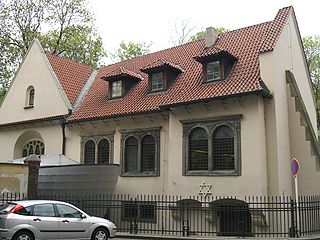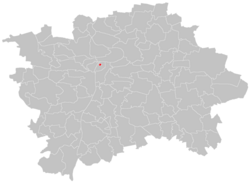
Boskovice is a town in Blansko District in the South Moravian Region of the Czech Republic. It has about 12,000 inhabitants. The area of the historic town centre, Jewish quarter, château complex and castle ruin is well preserved and is protected by law as an urban monument zone.

Turnov is a town in Semily District in the Liberec Region of the Czech Republic. It has about 15,000 inhabitants. It is a traditional centre for gemstone polishing, glass craftsmanship and arts. The historic town centre is well preserved and is protected by law as an urban monument zone.

Kolín is a town in the Central Bohemian Region of the Czech Republic. It has about 33,000 inhabitants. The historic town centre is well preserved and is protected by law as an urban monument reservation.

The Old New Synagogue, also called the Altneuschul, is an Orthodox Jewish congregation and synagogue, located in Josefov, Prague, in the Czech Republic. The synagogue is Europe's oldest active synagogue. Completed in 1270, it is also the oldest surviving medieval synagogue of twin-nave design.

Ivančice is a town in Brno-Country District in the South Moravian Region of the Czech Republic. It has about 10,000 inhabitants. The historic town centre is well preserved and is protected by law as an urban monument zone.

The Jewish Town Hall in Josefov, Prague, was constructed adjacent to the Old New Synagogue on the corner of Maiselova and Červená Ulice in 1586 in Renaissance style under the sponsorship of Mayor Mordechai Maisel. It acquired its Rococo facade in the 18th century.

Heřmanův Městec is a town in Chrudim District in the Pardubice Region of the Czech Republic. It has about 5,000 inhabitants. The historic town centre with the castle complex is well preserved and is protected by law as an urban monument zone.

The history of the Jews in Prague, the capital of today's Czech Republic, relates to one of Europe's oldest recorded and most well-known Jewish communities, first mentioned by the Sephardi-Jewish traveller Ibrahim ibn Yaqub in 965 CE. Since then, the community has existed continuously, despite various pogroms and expulsions, the Holocaust, and subsequent antisemitic persecution by the Czech Communist regime in the 20th century.

The High Synagogue, also called the Vysoká Synagogue, the official name in Czech: Vysoká synagoga, also known under its German synonym die Hohesynagoge, or as בה"כ גבוה Bet HaKnesset Gvuah in Hebrew or הויכשול Hoykhshil in Yiddish, is a Jewish congregation and synagogue, located on Červená ulice, Prague, in the Czech Republic. Used as a synagogue from 1568 until World War II, in tge postwar times it has for some time become part of the Jewish Museum of Prague. After being restituted in the 1990s by the Jewish Community of Prague, it has once again been used as a symbol synagogue ever since. It is used on daily basis for services of the members of the orthodox Prague Jewish community.

Kojetín is a town in Přerov District in the Olomouc Region of the Czech Republic. It has about 5,800 inhabitants.

The Old Jewish Cemetery is a Jewish cemetery in Prague, Czech Republic, which is one of the largest of its kind in Europe and one of the most important Jewish historical monuments in Prague. It served its purpose from the first half of the 15th century until 1786. Renowned personalities of the local Jewish community were buried here; among them rabbi Jehuda Liva ben Becalel – Maharal, businessman Mordecai Meisel (1528–1601), historian David Gans and rabbi David Oppenheim (1664–1736). Today the cemetery is administered by the Jewish Museum in Prague.

The Zamość Synagogue, also the Zamość Old Synagogue or the Great Synagogue of Zamość, is a former Jewish congregation and synagogue, located in Zamość, in Lublin Voivodeship, Poland. Completed in 1618 in the Renaissance style, the synagogue is a UNESCO-protected World Heritage Site of Poland. Erected during the times of the Polish–Lithuanian Commonwealth, it functioned as a place of worship for Polish Jews until World War II, when the Nazis turned the interior into a carpenters' workshop. The structure was spared from destruction and in 1992 was listed as a World Heritage Site as part of the Old City of Zamość.

The Maisel Synagogue is a Jewish congregation and synagogue, located in the former Jewish quarter of Prague, in the Czech Republic. The synagogue was built at the end of the 16th century in the Gothic Revival style. Since then its appearance has changed several times. The synagogue belongs to the Jewish Community of Prague and is administered by the Jewish Museum in Prague as a part of its exhibitions.

The history of the Jews in the Czech lands, historically the Lands of the Bohemian Crown, including the modern Czech Republic, goes back many centuries. There is evidence that Jews have lived in Moravia and Bohemia since as early as the 10th century. Jewish communities flourished here specifically in the 16th and 17th centuries, and again in the late 19th and early 20th centuries. Local Jews were mostly murdered in the Holocaust, or exiled at various points. As of 2021, there were only about 2,300 Jews estimated to be living in the Czech Republic.

Úsov is a town in Šumperk District in the Olomouc Region of the Czech Republic. It has about 1,200 inhabitants.

Nová Cerekev is a market town in Pelhřimov District in the Vysočina Region of the Czech Republic. It has about 1,200 inhabitants.

The Smíchov Synagogue is a former Reform Jewish congregation and synagogue, located at Stroupežnického 32, Smíchov, in Prague, in the Czech Republic. Completed in 1863, the former synagogue was remodelled in 1931 in the Functionalist style. After the World War II, the building was used for secular purposes because the Smíchov Jewish community ceased to exist in the Shoah. Since 1998, the building has been used as an archive of the Jewish Museum in Prague.

The Pinkas Synagogue is a former Jewish congregation and synagogue, located at Široká 3, in the Jewish Town of Prague, in the Czech Republic. Completed in 1535, the synagogue the second oldest surviving synagogue in Prague and was completed in the Gothic style. Its origins date from the 15th century and are connected with the Horowitz family, a renowned Jewish family in Prague. Today, the synagogue is administered by the Jewish Museum in Prague and commemorates approximately 80,000 Czech Jewish victims of The Shoah.

The Klausen Synagogue is a former Jewish synagogue located in Prague, in the Czech Republic.

The Stolpersteine in Prague-Josefov lists the Stolpersteine in the town quarter Josefov of Prague, the former Jewish quarter of the city. Stolpersteine is the German name for stumbling blocks collocated all over Europe by German artist Gunter Demnig. They remember the fate of the Nazi victims being murdered, deported, exiled or driven to suicide.






























